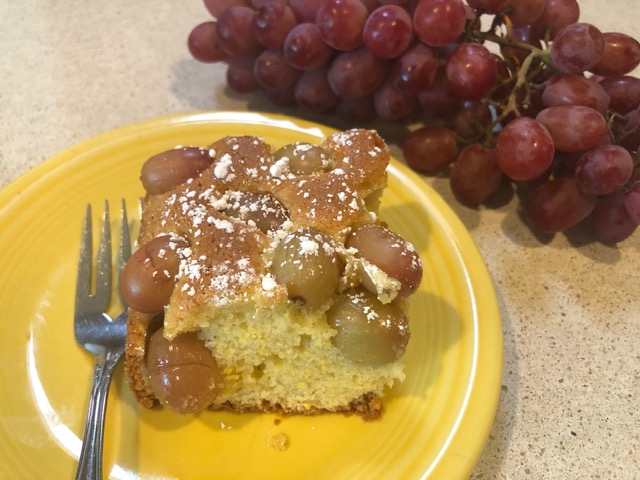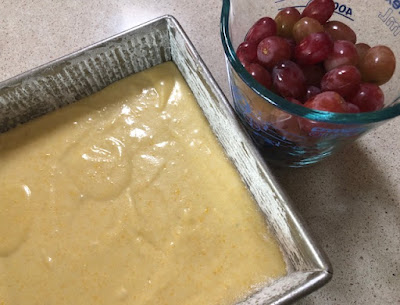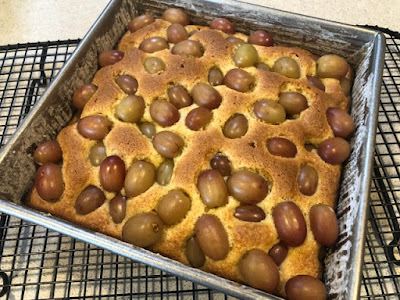
Recipe: Red grapes roast atop a lemon-scented batter
 |
| Grapes top the polenta-specked lemon and olive oil cake. (Photos: Kathy Morrison) |

|
The fruit at the farmers market right now exemplifies the change of weather and change of seasons: The last peaches and nectarines over here, the early-season persimmons and pomegranates over there. In between are pears, apples and, oh my, look at those grapes!
I don't buy grapes often, but the displays of red, green and black grapes from several vendors could not be ignored. I settled on two pounds of beautiful Crimson Flame grapes, and then dug into recipes to see how to use them.
This recipe, which has olive oil and polenta in the batter, is one I adapted from a gluten-free version on the blog This Mess is Ours. I guess I'm on an Italian-inspired baking kick this fall, but there's nothing wrong with that.
This cake is sweet enough to serve for dessert with espresso, but it's uncomplicated enough to be a breakfast cake. Other fruit could go on top instead of grapes, but try it first with your favorite red seedless. Left whole, the grapes roast into delicious little nuggets of flavor.
I used medium-grind polenta here, but if the grittiness would bother you, use fine-grind or even regular cornmeal.

The cake batter is ready to be topped with half the
grapes to begin baking.
|
Olive oil cake with polenta and roasted grapes
Serves 9-12
Ingredients:
1/2 cup almond flour or almond meal
1/2 cup good-quality olive oil, plus more for pan
1 cup unbleached all-purpose flour (can use gluten-free flour if desired), plus more for pan
1/4 cup polenta, fine or medium grind
1-1/2 teaspoons baking powder
1/2 teaspoon kosher salt
2 large eggs
2/3 cup sugar
Zest from 1 large lemon
1/3 milk (dairy or non-dairy, but not non-fat)
2 cups red seedless grapes, washed but left whole
Confectioner's sugar, for topping, optional
Instructions:
Heat oven to 350 degrees. Place a sheet of parchment paper on a rimmed baking sheet, and scatter the almond flour over the paper. Toast the almond flour in the oven for 4 to 5 minutes, until it is fragrant, but be careful not to scorch it. Remove from oven and allow to cool a few minutes.
Brush a round or square 8-inch pan with olive oil, then dust with a bit of all-purpose flour.
In a medium bowl, whisk together the all-purpose flour, the toasted almond flour, polenta, baking powder and kosher salt.
In a large bowl, use an electric mixer to beat together the eggs, sugar and lemon zest on high until the mixture is light and fluffy. With the mixer on low speed, stream in the olive oil until combined. Then, alternately add the flour mixture and the milk, starting with about one-third of the flour, then half the milk. Repeat, then stir in the remainder of the flour.

Fresh out of the oven, the cake can be topped with
confectioner's sugar or left plain. |
Spread the batter in the prepared pan. Scatter about 1 cup of the grapes over the top of the batter. Bake for 15 minutes, then add the rest of the grapes to top, pressing down on them just slightly. Continue baking for 25 to 27 minutes more, until the cake is golden brown and a toothpick inserted in the center comes out clean.
Allow cake to cool about 15 minutes on a wire rack. Sprinkle confectioner's sugar on top, if using, and slice to serve.
Comments
0 comments have been posted.Sacramento Digs Gardening to your inbox.
Sites We Like
Garden Checklist for week of May 12
Get your gardening chores and irrigation done early in the day before temperatures rise.
* Plant, plant, plant! It’s prime planting season in the Sacramento area. Time to set out those tomato transplants along with peppers and eggplants. Pinch off any flowers on new transplants to make them concentrate on establishing roots instead of setting premature fruit.
* Direct-seed melons, cucumbers, summer squash, corn, radishes, pumpkins and annual herbs such as basil.
* Harvest cabbage, lettuce, peas and green onions. This heat will cause leafy greens and onions to flower; pick them before they bolt.
* In the flower garden, direct-seed sunflowers, cosmos, salvia, zinnias, marigolds, celosia and asters.
* Plant dahlia tubers. Other perennials to set out include verbena, coreopsis, coneflower and astilbe.
* Transplant petunias, marigolds and perennial flowers such as astilbe, columbine, coneflowers, coreopsis, dahlias, rudbeckia and verbena.
* Keep an eye out for slugs, snails, earwigs and aphids that want to dine on tender new growth.
* Feed summer bloomers with a balanced fertilizer.
* For continued bloom, cut off spent flowers on roses as well as other flowering plants.
* Got fruit trees? If you haven't already done so, thin orchard fruit such as apples, peaches, pears, pluots and plums before they grow too heavy, breaking branches or even splitting the tree. Leave the largest fruit on the branch, culling the smaller ones, and allow for 5 to 6 inches (or a hand's worth) between each fruit.
* Thin grape bunches, again leaving about 6 inches between them. For the remaining bunches, prune off the "tail" end, about the bottom third of the bunch, so that the plant's energy is concentrated in the fruit closest to the branch.
* As spring-flowering shrubs finish blooming, give them a little pruning to shape them, removing old and dead wood. Lightly trim azaleas, fuchsias and marguerites for bushier plants.
* Add mulch to the garden to help keep that precious water from evaporating. Mulch also cuts down on weeds. But don’t let it mound around the stems or trunks of trees or shrubs. Leave about a 6-inch to 1-foot circle to avoid crown rot or other problems.